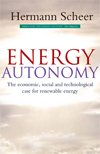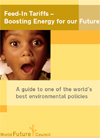 Article published in Scheer, H. / Ghandi, M. / Aitken, D. / Hamakawa, Y. / Palz, W. (Ed.): The Yearbook of Renewable Energies 1995/96: Solar Energy – What are its Driving Forces ?, London, 1995
Article published in Scheer, H. / Ghandi, M. / Aitken, D. / Hamakawa, Y. / Palz, W. (Ed.): The Yearbook of Renewable Energies 1995/96: Solar Energy – What are its Driving Forces ?, London, 1995Introduction
Many people think the question of the share of renewable energies in the energy supply is merely scientific. The truth is: the discussion of the potential of renewable energies is an almost entirely political one. It cannot be seriously denied that there is a natural renewable energy potential sufficient to satisfy forever the energy needs even of an increasing world population. Neither can be denied that there are numerous - already applied - technologies for using this potential. Therefore it is only a question of how many economic and political initiatives for the utilization of renewable energies are input until there is output completely meeting the energy needs.
This can be disproved by only two counter arguments:
• If the amount of energy necessary to produce the solar technologies surpasses the amount of energy yielded by means of these technologies. But we know this energy amount to be distinctly lower: for photovoltaic modules, the energy payback time is less than two years, for wind power stations it is less than six months - and the trend is continuously decreasing.
• If, for the utilization of solar technologies, a certain material were indispensable, being available only in limited amounts only and, moreover, exhaustible. But we know that this, too, is not the case.
Thus there is no objective limit for the utilization of renewable energies that mankind could ever reach, even if today's world population increased tenfold or more. An increasing population would overstrain only some specialized renewable energy sectors - the utilization of hydropower and of biomass - but not solar radiation, wind power and wave power.
It is therefore astonishing that, in spite of these facts, there is such great debate about the possibili-ties of renewable energies. There is only one likely reason: the arguments that renewable energies have limited potential justifies the continued utilization of nuclear and fossil energies. The proponents of this argument are either ill informed or arguing ideologically in favor of conventional energies. Their ideas are simply unscientific.
We do not want to play down the efforts necessary for a conversion of the energy supply to renewable energies, especially the economic demands. The most important questions concerning the potentials of renewable energies are:
• How can the necessary economic forces be mobilized?
• What must the renewable energy mix be like?
This last question in particular cannot be clearly answered as the structure of the renewable energy mix depends on the geographic and bioclimatic conditions of each country.
Part of this edition of the Yearbook deals with the question of potentials. Therefore we are including record several studies, some written in the 1970s, describing the route to a 100% renewable energy base and its possible structure. They show a spectrum of possibilities and should not be seen as a precise simulation of a future pattern. For there cannot be a firm prognosis of how large the share of one renewable energy source may be compared with the others. The answer to that question depends not only on the natural conditions of the specific country, but also on the technological and economic development of the various energy sources, the rapidity of renewable energies introduction cannot be forecast.
Within the discussion about the potentials of renewable energies, these steps are the only matters of conjecture. The contributions on potentials presented here aim to demonstrate the central feasibility, of introducing 100% renewable energies.



